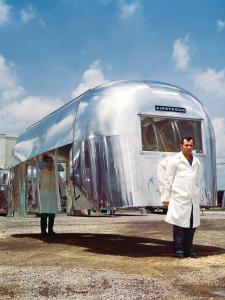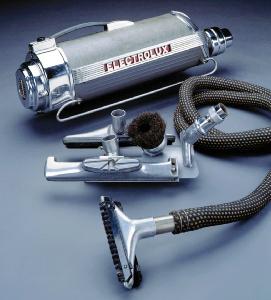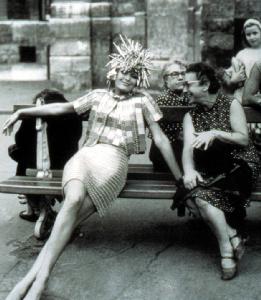
Aluminum by Design: Jewelry
to Jets
By
EllenS. Wilson
October
28, 2000 - February 11, 2001
Carnegie
Museum of Art
The
summer I was 19, I lived in an aluminum Airstream trailer and waited tables
at a resort in the Smoky Mountains.I
did not know that I was living in a classic of American design.I
only knew that ants dropped out of the North Carolina pine trees, made
their way through the vintage roof, and down onto my head as I slept.
Aluminum
is a material that just about everyone has a connection to, whether it
is through your grandmother’s egg poacher, the space frame for your new
Audi, or the Eames chair you sat in when your last flight was delayed.First
discovered about 150 years ago, it has gone from scientific marvel, to
rare and precious “silver from clay,” to aninexpensive
and lightweight material ubiquitous in modern living.An
innovative, even inspired, choice for designers, it connotes lightness,
purity, and speed.Today, as much
as it ever was, it is the metal of the future.Aluminum
by Design: Jewelry to Jets is the first major international loan exhibition
to explore how aluminum has inspired creativity since its discovery.
“Aluminum
had a rhetoric attached to it from its very beginning,” explains exhibition
organizer Sarah Nichols, the museum’s chief curator and curator of decorative
arts.“God had provided all the
tools for human existence, it was believed, but some were more awkward
to get at than others.”

German
chemist Friedrich Wöhler first produced shiny, pinhead-sized aluminum
blobs in 1845 that were nevertheless large enough to reveal some of the
new metal’s physical properties.Wöhler’s
results were intriguing, but it took almost ten years of further work before
aluminum was a useable substance.This
time, Henri Sainte-Claire Deville, of the Ecole Normale in Paris, improved
on Wöhler’s results, and found that aluminum was malleable, impervious
to some acids, and incredibly light. Heartened by his success, Deville
intended to produce aluminum commercially.
This
was not so easily done.Aluminum
as a novelty was warmly welcomed by a 19th century that was
learning to have faith in technology, but it was an expensive little marvel
that no one saw the need for initially.
The
next major turning point for aluminum was in 1886, when the young Charles
Martin Hall of Ohio, working in the family woodshed, ran an electric current
through a solution of alumina and cryolite and produced globules of pure
metal.(Oddly, Paul T. L. Héroult
of Paris, working independently but simultaneously, made the exact same
discovery.Clearly, aluminum’s time
had come.) This success, and the recent advent of reliable and inexpensive
electricity, led Hall and his backers to found the Pittsburgh Reduction
Company, which eventually became Alcoa.
Once
a smelter is set up, it must run continuously, and so aluminum went from
being scarce to plentiful in a very short time.“There
was a feeling that aluminum could improve life, but no one knew how at
first,” explains Nichols.Initially,
the manufacturers tried everything in their search for uses for the new
material.“This was not necessarily
the way to go,” Nichols comments, pointing to the aluminum violin as a
shining example.Designers had to
choose what was appropriate to the material, what objects would best take
advantage of its light weight and good looks.
It
was in the domestic sphere that aluminum’s usefulness was immediately recognized.The
home, in the early days of the 20th century, was a radically
different place from what it had been just a few decades earlier.The
rise of the middle class changed the role of the homemaker from that of
general manager with servants to someone who actually did the cooking and
cleaning herself.The media corroborated
in putting forth images of the ideal home – bright, light and easy, just
like aluminum itself.Aluminum cookware
was sanitary, easy to cook in without scorching, easy to clean up.One
advertisement showed a bride in her wedding gown gazing lovingly at her
new pots and pans.
It
wasn’t long, however, before aluminum came out of the kitchen and into
the front hall, the dining room, and other public spaces.Initially,
aluminum furniture was easier to accept when it resembled old familiar
substances, and early furniture by Alcoa relied on traditionally styled
legs that resemble turned wood, or aluminum painted with a wood grain.
“Imitation and substitution tend to be the first stage in the history of
any new material,” Nichols points out in her essay in the exhibition catalogue.Eventually,
consumers grew more comfortable with the modernist look, and with the changing
role of technology that came with it.The
furniture from this periodno longer
harks back to the Arts and Crafts tradition, but is clearly machine made,
with decoration subordinate to form.
“The
1930s were a real heyday for aluminum,” says Nichols.“The
metallic look was popular then, and aluminum could be formed in a way that
suited the prevailing aesthetic.”
If
aluminum seemed made for one purpose, it was transportation.The
Airstream trailer seemed to embody the new values of the 1930s – mobility,
importance of family, leisure time, and disposable income.Higher
on the socio-economic ladder is the aluminum-bodied Rolls Royce, establishing
once and for all that this metal, for all its practicality, could still
be elegant.By the mid 1930s, aluminum
was used extensively in trains and buses. Its very lightness meant that
aluminum vehicles were built for speed, that cars made of aluminum would
get there first, and look good in transit.
The
transportation industry in turn influenced other aspects of design.“Streamline
became in the 1930s and 1940s the American national style for everyday
objects,” Paola Antonelli writes in the exhibition catalogue. Everything,
from cocktail shakers to pencil sharpeners to vacuum cleaners, looked as
if it were about to take off.The
look was optimistic, futuristic, and totally new.

World
War II was the next great turning point in the history of aluminum.Its
use in consumer goods was prohibited but production rose as all manufacturing
efforts were devoted to the war.When
it was over, the dramatic increase in production had to be sustained with
new markets for aluminum.In the
meantime, however, the aesthetic had changed.The
atomic age had arrived, and if glasses were raised to the new world order,
they were likely to emit the anodized and otherworldly glow of Colorama.There
was to be no more hiding under a fake wood finish.
If
aluminum has from its beginning been the metal of the future, that future
was predicted early on.Jules Verne,
in From the Earth to the Moon, wrote that it “seems to have been
created with the express purpose of furnishing us with the material for
our projectile.” Viscount de Ponton d’Amécourt, founder of the Society
for the Encouragement of Aerial Navigation by Heavier-than-Air Machines,
created a small model of a steam helicopter in 1863, but for various reasons
did not pursue his project.As Nichols
writes in the catalogue, such “flights of fancy are what fuel invention.”It
seems fair to say that the air and space industry were in some ways waiting
for the development of aluminum before they themselves could take off.Aluminum
makes up nearly 80% of the typical aircraft, and is used in large quantities
in the space shuttle as well.
Although
aluminum reigns supreme in such practical uses as beverage cans and lawn
furniture, the 70s and early 80s were given over to plastic. It wasn’t
until the late 80s and the 90s that aluminum became stylish again.Recently
heralded as “the alluring surface du jour” in a special New York Times
Sunday magazine devoted to the near future (June 11, 2000), it is no surprise
to find innovative uses for the metal again coming out of the studios of
contemporary designers.Paco Rabanne
designed dresses of aluminum both in 1969 and in 1999.
As
Nichols says, people are prepared to pay for design now.She
picks up a small aluminum mug from the trendy Japanese store Muji.It
is a beautiful thing, light and clean looking, its well-proportioned handle
riveted neatly to the body.Nichols
keeps her pencils in the mug; it is, obviously, useless for hot tea.“It’s
a style, an aesthetic,” she says.“There
is more consciousness about materials today than ever before.Michael
Graves is designing aluminum housewares for Target.Design
is a hot topic.”

Aluminum
has the gift of looking, to modern eyes, both retro and futuristic.As
the world becomes more crowded, and resources scarcer, aluminum’s lightness
and its ability to be endlessly recycled appeal to us on both practical
and emotional levels.Those early
marketers were right, aluminum is more than a material, it is a way of
life – fast, easy, and clean, morally sound yet fun.If
aluminum is really the metal of the future, then the future looks better
than ever.
Aluminum
by Design:Jewelry to Jets
is made possible by the generous sponsorship of Alcoa Foundation.
Significant
support has also been provided by Audi of America, Inc.
Additional
major support has been provided by The Roy A. Hunt Foundation, The Arthur
Vining Davis Foundations, and the Commonwealth of Pennsylvania.
Funding
has also been provided by the Anne and George Clapp Charitable Trust, The
Grable Foundation, and Perfido Weiskopf Architects.

